|
Kancheepuram History
|
|
Kanchipuram is hailed as textile city the place is both handloom as well as machine
woven silks sarees. The sarees manufactured here are famous across the globe. Kanchipuram
town is also known as Silk City since the main profession of the people living in
and around is weaving silk sarees, more than 5,000 families are engaged in this
industry. The silk weavers of Kanchipuram settled more than 400 years ago and have
given it an enviable reputation as the producer of the best silk sarees in India.
Woven from pure mulberry silk and have an enviable reputation for texture, durability
and finish. The sarees in dazzling colors are available in every imaginable design
and variety.
Kanchipuram has magnificent temples of unique architectural beauty bearing eloquent
testimony to its glorious Dravidian heritage. Adi Sankara established his episcopal
seat (Kamakotipeetam). Kanchipuram is the birth place of C.N. Annadurai, former
Chief Minister of Tamil Nadu affectionately called as "Anna" by the people of Tamil
Nadu.
|
|
|
|
|
|
|
|
|
Kamakshi Amman Temple
|
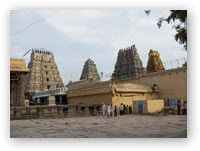
|
|
|
|
The Kamakshi Amman Temple is one of the three holy places of Sakthi worship
in India, The temple has an imposing structure and is dedicated to goddess Parvati
in her incarnation as Kamakshi, the goddess of Love. The temple in the present form
was built by the Cholas during 14th centuary A.D. The Kamakshi Amman temple is the
hub of all religious activities in Kanchipuram. The temple is also in closer control
of the Sankara Mutt.
|
|
|
|
|
The Kanchi Sankaracharya Mutt and kammakshiamman temple are closely associated with
the life of Sankaracharya. The Kanchi Sankaracharya Mutt is enshrined in the Sri
Chakra just in front of Sri Devi and all pujas and sacrifices are offered to the
Sri Chakra.
Adi Sankara, founded Mutts at Badrinath in the north, Dwarka in the west, Puri in
the east and Sringeri in the south syhmbolizing the cultural unity of India even
2000 years back. He came to Kanchipuram towards the end of his life and installed
the Sri Chakra in the Kamakshi temple. He founded the Kanchi Kamakoti Peetam as
the central and last Mutt before he departed at Kamakshi temple itself in 476 BC.
There is a shrine devoted to the Adi Sankara at the very entrance to the temple
at Kanchipuram.
|
|
|
Kanchi Sankaracharya Mutt
|
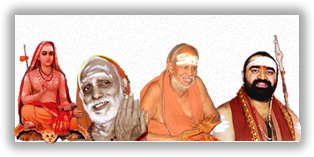
|
|
|
|
|
|
Kailasanathar Temple
|
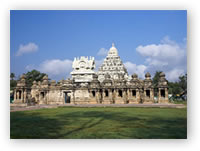
|
|
|
|
The Kailasanathar Temple is one of the oldest temples and it was constructed
by the Pallava kings in the 8th century AD. It also contains numerous panels showing
lord Siva as Nataraja in various postures. The architecture of this temple resembles
the Shore Temple at Mahabalipuram.The temple is built of red sandstone and has innumerable
carvings of Pallva art, of which the Urdhva Thandava dance of Siva and the laughing
face of Parvathi are worth seeing.
|
|
|
|
|
The Ekambareswarar Temple is one of the famous Hindu temples dedicated to
Lord Shiva. The 57 metres (188") high Rajagopuram is one of the tallest towers in
South India which was built by the Vijayanagar King, Krishnadevaraya. The temple
covers an area of over 40 acres. The temple's inner walls are decorated with an
array of 1,008 Siva lingams.The sthala-virutcham is a 3,500 year old mango tree
whose branches give four different types of mangoes.
|
|
|
Ekambaranathar Temple
|
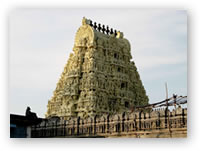
|
|
|
|
Vaikuntaperumal Temple
|
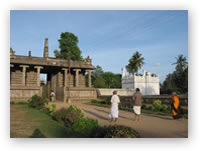
|
|
|
|
The Vaikunta Perumal Temple is built by the Pallava ruler, Nandivarman in
the 7th century AD. It is dedicated to Lord Vishnu and its inner walls are decorated
with lion shaped pillars. Inside the temple the presiding deity (Lord Vishnu) is
shown in the sitting, standing and reclining postures.
|
|
|
|
Go to Top
|
|
|
|
|
The Varadaraja Temple is one of the important shrines of Sri Vaishnavites,
also known as "Hastigiri".The main deity here is Varadaraja Perumal in a standing
posture facing west and the Lord here is also known as "Devaraja", "Pranatharthihara",
"Deva Perumal", "Athiyooran" and "Perarulalan".
|
|
|
Varadarajar Perumal Temple
|

|
|
|
|
|
|
Kumara Kottam Temple
|
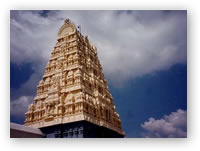
|
|
|
|
The Kumara Kottam Temple is located in between the Kamakshi and Ekambareshwar
temples in the Somaskanda formation in the town of Kanchipuram. In the sanctum,
Muruga is in a seated pose. Valli, Deivayani are absent here, but their festival
idols are kept here. In accordance with the function of Creation he has assumed,
his right arm is in Abaya pose, the upper hand holds the rosary, and the lower left
arm is on the thigh in Katyavailambita pose with the left arm holding the Kamandalam.
The posture is also called "Brahma Chattam".
|
|
|
|
|
|
|
The Ulahalanda Perumal Temple was bulit in chola period and its situated
about half a kilometer from the centre of the town near Kamakshi Amman temple is
one of the oldest temples in Kanchipuram. The main deity of this temple is 35 feet
high and 24 feet wide posing with one foot on earth and the other on the sky. This
form is called Trivikrama.This temple is one of the 108 Divya Desam's of Lord Vishnu.
|
|
|
Ulagalandha Perumal Temple
|
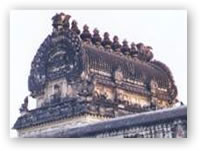
|
|
|
|
|
|
kacchapaeswarar Temple
|
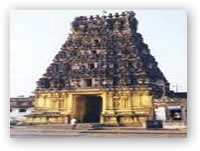
|
|
|
|
The Kacchapa Eswarar Temple was built by Pallava Dynasty. In this temple,
siva appears as being worshipped by vishnu in the form of turtle (kurmemerali).
"Kacchapam" is Sanskrit for "Turtle". Hindu mythology suggests that the main deity
in this temple (Lord Shiva) was worshipped by Lord Vishnu in the form of a Turtle.
|
|
|
|
|
|
Go to Top
|
|
|